Art
Advertising
- Advertising
- Tin (Cassiterite) Distribution: Mediterranean Bronze Age
- Archaeological Sites of the Aegean Minoans
- Extent of Santorini Eruption's Tsunami Inundation of Minoan Crete
- End of Minoan Linear A Writing and LM IB Fire Destruction of Crete
-
The Cause of the End of the Bronze Age
with the Scientific Method -
Nature Geoscience Journal and
Late Minoan IB Destruction Event - Prehistoric Star Navigation, Eastern Mediterranean Ethnocentric Bias, and the "Cabal of Certainty"
- Theoretical Bronze Age Minoan Heliographic Aegean Network Validated by 92.15 Mile (148.3 Km) Mirror Sunlight Flashes
- The Validation of a Bronze Age Minoan Heliographic Aegean Network in Southern California
- Tsunami Generation from the Titanic Bronze Age Minoan Eruption of the Santorini Marine Volcano
- The Cento Camerelle Mines of Tuscany: A Major Bronze Age Source of Tin
- No Men or Sails Required: Successful Prehistoric Sea Travel
- Minoan Downfall and Volcanology's Black Hole of Unknowns
- Homer and Navigating by the Stars in Prehistory
- Primacy of Human Powered Rowing in Copper Age and Minoan Shipping
- Minoan Invention of the True Dome and Arch Prehistoric Mediterranean Catenary Architecture
- "Sinking Atlantis" Tsunami Myth Debunked
- Minoan Tholos Structural Mechanics and the Garlo Well Temple
- Minoan Web of Mirrors and Scripts
- Santorini Eruption and LM IB Destruction
- Minoan Catastrophe: Pyroclastic Surge Theory
- Early Minoan Colonization of Spain
- Origin of the Sea Peoples
- Minoan Ship Construction
- Minoan Maritime Navigation
- Ringed Islands of Thera, Santorini, Greece
- Minoan Scientific Tradition
GIS Google Earth
Publications
Publications
Official Art Gallery
A Collection of 20 Paintings each with over 70 Art Products

The long-nosed men depicted on the Warriors Vase are traditionally
dressed as Shardana (or Sherden) Warriors with Horned Helmets and
small rounded Shields from Sardinia in the western Mediterranean
and NOT the static traditional garb of the Mycenaeans with their
Boars Tusk Helmets and their large figure eight Shields.
Therefore, this is a depiction of their Conquerors
after the Mycenaean defeat!
Heinrich Schliemann found this Krater
on the Acropolis Close to Circle A
Mycenae, Greece
about 1200 BC
dressed as Shardana (or Sherden) Warriors with Horned Helmets and
small rounded Shields from Sardinia in the western Mediterranean
and NOT the static traditional garb of the Mycenaeans with their
Boars Tusk Helmets and their large figure eight Shields.
Therefore, this is a depiction of their Conquerors
after the Mycenaean defeat!
Heinrich Schliemann found this Krater
on the Acropolis Close to Circle A
Mycenae, Greece
about 1200 BC
Preface
The following publication is based on the “Scientific Method” with its full repertoire of investigative techniques including Logic, Probability, Deductive Reasoning, Inductive Reasoning, Cause and Effect and, most importantly, “All” the available “highly confirmable” evidence from throughout the entire Bronze Age Mediterranean basin. Due to the Bronze Age’s chronological uncertainty at this time I will be relying on my application of logic and reasoning for the sequence of events. This should be considered as a testable hypothetical theory that needs to be modified or refined as new hypotheses are introduced under the guidelines of the scientific method.
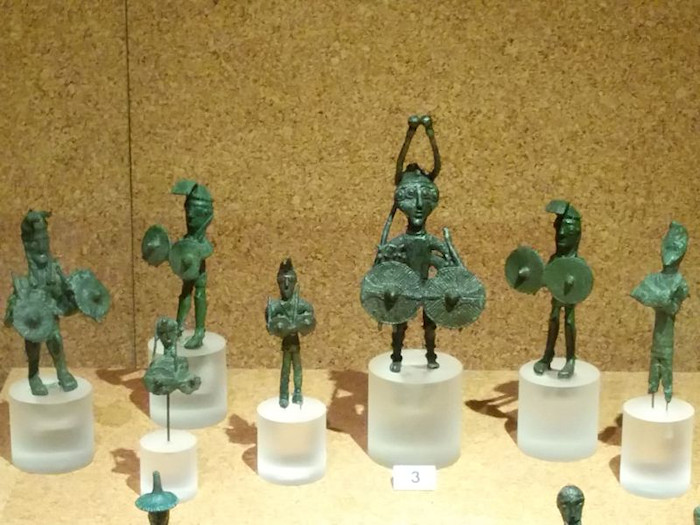
Bronzetti Nuraghic Warriors
Sardinia, Bronze Age, Nuraghic Era
Sardinia, Bronze Age, Nuraghic Era
The Bronze Age Santorini (Thera) Volcanic Eruption
Once upon a time, in about 1600 BC, the largest super volcano along the Hellenic (or Aegean) Arc where the subduction of the African plate beneath the Eurasian plate exploded colossally over a period of three (3) or four (4) days. This was one of the largest eruptions in the last 10,000 years. This is the submerged marine volcanic crater of the ringed islands of Thera (modern-day Santorini) in the southern Aegean Sea about 70 miles (113 Kms) north of the island of Crete. Santorini is much bigger than Krakatoa in Indonesia.
It’s highly probable this eruption was the cause of the LMIB Destruction Horizon of central and eastern Crete given the present uncertainty of the sequence of events during this era. This wide spread destruction that essentially ended Linear A writing and severely weakened the Minoans on Crete must have had a very large cause. I’ve hypothesized that a massive explosion of super-heated steam struck Crete similar to the much smaller Mt. Pelee eruption in the Caribbean on May 8th, 1902 in which about 30,000 people were burned to death by super-heated steam in the city of Saint-Pierre on the island of Martinique. In the heat of the Caribbean spring the suffocating stench was so intense that the thousands of bodies of the dead were simply gathered into great piles and burned.
The 1600 BC Santorini eruption would have had serious implications for the Hyksos in Avaris, Egypt, as well, who I think the Minoans were a significant component of the "ruler(s) of foreign lands" that held sway over Egypt during the Second Intermediate Period but I will discuss this in another publication in the future.
It’s highly probable this eruption was the cause of the LMIB Destruction Horizon of central and eastern Crete given the present uncertainty of the sequence of events during this era. This wide spread destruction that essentially ended Linear A writing and severely weakened the Minoans on Crete must have had a very large cause. I’ve hypothesized that a massive explosion of super-heated steam struck Crete similar to the much smaller Mt. Pelee eruption in the Caribbean on May 8th, 1902 in which about 30,000 people were burned to death by super-heated steam in the city of Saint-Pierre on the island of Martinique. In the heat of the Caribbean spring the suffocating stench was so intense that the thousands of bodies of the dead were simply gathered into great piles and burned.
The 1600 BC Santorini eruption would have had serious implications for the Hyksos in Avaris, Egypt, as well, who I think the Minoans were a significant component of the "ruler(s) of foreign lands" that held sway over Egypt during the Second Intermediate Period but I will discuss this in another publication in the future.
The Eruption’s Aftermath
Just after the Minoan catastrophe on Crete with the volcanic eruption combining with the LMIB destruction horizon where, quite probably, the population of central and eastern Crete was decimated there would have been a time of disbelief, astonishment, and an effort to confirm the devastating news. The Minoan’s shipping to the western Mediterranean, Black Sea, Egypt, and elsewhere would have suddenly ceased leaving their many trading partners in wonderment and shock. As month after month passed with little or no Minoan ships appearing the people of distant lands began to reevaluate their situation.
Besides the trading “only” ports, the Minoans were an important provider of immigrants especially for the western Mediterranean. As all populations expanded beginning in the Neolithic, this expansion was particularly acute on an island with a finite landmass like Minoan Crete. The authorities probably offered incentives for anyone wanting to find their fortune in far away eastern coastal Spain among the Argarics with its thriving silver trade as well as places like the islands of Sicily and Sardinia or the western Italian coast of present day Tuscany or anywhere throughout the Mediterranean basin and beyond.
The original Cardial Neolithic settlers arrived in Iberia in about 5600 BC. But the vast mineral riches of the Iberian Pyrite Belt with its gold, silver, tin and copper was too tempting for the exploring Early Minoan mariners. The “Los Millares” settled in Santa Fe de Mondujar by about 3200 BC to begin exploiting these minerals. This set into motion a long conflict over mineral resources and the land they could be found in that would last until sometime after the great eruption of Santorini. The attacks of the original Cardial Neolithic tribal settlers are expressed by the highly defensive nature of the Millarens’, and later the Argarics, settlements and fortifications. The tribes possessed Cassiterite (Tin) in great quantities in western Iberia and often attacked the Argarics with superior bronze weaponry.
Without immigration support from the Minoans the Argarics eventually, in ever increasing numbers, decided to evacuate eastern Spain under the attacks of the Cardial tribes. One large hilltop settlement in present-day Murcia, perhaps even an Argaric capitol, La Bastida was suddenly abandoned in the wake of the Minoan catastrophe especially after the Mycenaeans conquered Minoan Crete and began prowling the western seas of the Mediterranean with ships of their new fleet looking for the fruits of plunder. Where they went, no one knows for sure. But surely some would have taken over the sea to Sardinia and elsewhere throughout the Mediterranean.
Besides the trading “only” ports, the Minoans were an important provider of immigrants especially for the western Mediterranean. As all populations expanded beginning in the Neolithic, this expansion was particularly acute on an island with a finite landmass like Minoan Crete. The authorities probably offered incentives for anyone wanting to find their fortune in far away eastern coastal Spain among the Argarics with its thriving silver trade as well as places like the islands of Sicily and Sardinia or the western Italian coast of present day Tuscany or anywhere throughout the Mediterranean basin and beyond.
The original Cardial Neolithic settlers arrived in Iberia in about 5600 BC. But the vast mineral riches of the Iberian Pyrite Belt with its gold, silver, tin and copper was too tempting for the exploring Early Minoan mariners. The “Los Millares” settled in Santa Fe de Mondujar by about 3200 BC to begin exploiting these minerals. This set into motion a long conflict over mineral resources and the land they could be found in that would last until sometime after the great eruption of Santorini. The attacks of the original Cardial Neolithic tribal settlers are expressed by the highly defensive nature of the Millarens’, and later the Argarics, settlements and fortifications. The tribes possessed Cassiterite (Tin) in great quantities in western Iberia and often attacked the Argarics with superior bronze weaponry.
Without immigration support from the Minoans the Argarics eventually, in ever increasing numbers, decided to evacuate eastern Spain under the attacks of the Cardial tribes. One large hilltop settlement in present-day Murcia, perhaps even an Argaric capitol, La Bastida was suddenly abandoned in the wake of the Minoan catastrophe especially after the Mycenaeans conquered Minoan Crete and began prowling the western seas of the Mediterranean with ships of their new fleet looking for the fruits of plunder. Where they went, no one knows for sure. But surely some would have taken over the sea to Sardinia and elsewhere throughout the Mediterranean.
Sardinia and the Tuscan Tin Mines
The Sardinians would have treated their actual source of Tin (the Cento Camerelle Mines in Monte Valerio, Campigliese, Tuscany on mainland Italy as a military secret of the highest order. Apparently, the Mycenaeans never did find out where these mines were. They probably assumed they were somewhere on Sardinia and would find the Tin mines if they searched the entire island so they could take it as loot instead of paying the high prices for imported Tin from Afghanistan in Byblos or Egypt.
The Mycenaeans
After the Santorini eruption where the Minoans on Crete suffered the brunt of the destruction and the Mycenaeans emerged relatively unscathed, they must have felt like “God’s chosen people”. This would have been actively promoted by the political elites in power. Once the Mycenaeans invaded and destroyed Minoan Crete with their new fleet and thoroughly looted its wealth, they began to build the palace at Mycenae to house their “God-like” elites. What followed was a period of consolidation of wealth and power. Minoan Pylos in western Peloponnese was attacked and taken, at about the same time, or not long after Crete was conquered.
Probably beginning in the 15th century BC the Mycenaeans began sending small groups of ships on voyages of exploration into the western Mediterranean posing as innocent traders from the Aegean to gather intelligence to see what valuable resources they could most easily exploit. After thoroughly exploring the western Mediterranean coastlines, the Mycenaeans decided that Sardinia was, by far, the richest and most available prize in terms of agricultural products (einkorn/emmer wheat, barley, olives, grapes, domesticated animals, etc.), copper, and the hint of tin mines as expressed in their bronze wares. With this decision they began to plan for their first large-scale murderous amphibious raid on southern Sardinia along the beaches of the Gulf of Cagliari immediately after the wheat harvest. This was where the richest concentration of wheat fields were and they would search for any mining activity they could find – Copper and especially Tin. They would steal everything they could get their hands on and kill everyone within reach of their weapons.
Probably beginning in the 15th century BC the Mycenaeans began sending small groups of ships on voyages of exploration into the western Mediterranean posing as innocent traders from the Aegean to gather intelligence to see what valuable resources they could most easily exploit. After thoroughly exploring the western Mediterranean coastlines, the Mycenaeans decided that Sardinia was, by far, the richest and most available prize in terms of agricultural products (einkorn/emmer wheat, barley, olives, grapes, domesticated animals, etc.), copper, and the hint of tin mines as expressed in their bronze wares. With this decision they began to plan for their first large-scale murderous amphibious raid on southern Sardinia along the beaches of the Gulf of Cagliari immediately after the wheat harvest. This was where the richest concentration of wheat fields were and they would search for any mining activity they could find – Copper and especially Tin. They would steal everything they could get their hands on and kill everyone within reach of their weapons.
The Amphibious Mycenaean Raids on Sardinia
On the road from Mycenae through Tiryns to the south you come to the Mycenaean port of Naplion (present day Nafplio) on the east side of the northern coast of the Gulf of Argolis. This would have been the departure port for warriors in the east near to Mycenae. They would make their way to a wide beach in the western Peloponnese just to the west of Pylos which was the gathering point of the Mycenaean fleet for their voyage to the landing beaches of Cagliari in southern Sardinia. This voyage from Pylos would have taken over eight (8) days traveling at an easily maintainable ship speed of 3.5 Knots (3.5 nautical miles/hour = 4.03 miles/hour) which is the equivalent to the walking speed of a human for 24 hours a day in shifts to reach the beaches of Cagliari in Sardinia (Google Earth: ~750 miles, 651 nautical miles, 1,207 kilometers, 1,049 nautical kilometers, 186 hours, 7.8 days) and over nine (9) days to land on the shores of the western Gulf of Oristano (868 miles, 754 nautical miles, 1,397 kilometers, 1,214 nautical kilometers, 215 hours, 8.9 days).

Mycenaean Ship
Mycenae, ~1200 BC
Mycenae, ~1200 BC
These first raids overwhelmed the Sardinians and they began yearly large-scale raids using several hundred ships with at least fifty (50) warriors per ship all around the island. These usually were around wheat harvest time but could be on any coast or time of the year. The Mycenaeans desperately needed to know the mining source of Sardinian Cassiterite and where they processed it into Tin. It must have been very intimidating for the Sardinians to see tens of thousands of Mycenaean warriors attacking their homeland. This pathologically merciless first raid would have taken the Sardinians completely by surprise and resulted in a large number of men, women, and children killed and maimed with a significant loss in crops, animals, and metal objects.
The Sardinian Reaction, Troy VI, and the Lycian Peninsula
After successive raids all around their coastlines the reaction to these amphibious attacks was the absolute unification of all the different groups populating Sardinia at the time against the common hated Mycenaean enemy. A grand island-wide political/military counsel led by either a group of leaders or a single charismatic leader came to, first, unite all the people of Sardinia behind them and, second, to mobilize and organize the entire population for a common defense against the Mycenaeans. This included plans for a massive construction program, given the weaponry of the day, of as many tholos fortresses, large and small, that could be used as defensible warning watchtowers with the use of fires, horns, and communications devices such as flags and bronze mirrors as well as providing shelter for as many of the islanders and their livestock as possible. It's important to note the Mycenaeans never were successful in taking any land on Sardinia. The island must have had a sufficiently strong population to repel any attempt to do this and the Mycenaeans knew it. In the 14th century BC the Sardinians began to blunt these amphibious attacks and the ongoing Mycenaean search for Cassiterite (Tin) mines on the island with their own counterattacks and began building their own fleet of militarized ships.
Due to the Sardinian’s abundant tholos fortress defenses, now in the thousands, and their tactics of resistance (early harvests, protection for their domesticated animals, etc.) which diminished the wealth the Mycenaeans could obtain from their raids they began to look for other ways to feed their people and plunder the wealth of their neighbors. Around 1350 BC they began to seriously look at plundering Troy VI on the south shore to the western entrance of the Dardanelles and beginning the massive work of draining Lake Kopais in central Boeotia to plant great fields of wheat. The Sardinians sustained program of defensive tholos fortress construction would continue into the 13th century BC and eventually comprise several tens of thousands of fortresses, large and small, throughout the island.
Due to the Sardinian’s abundant tholos fortress defenses, now in the thousands, and their tactics of resistance (early harvests, protection for their domesticated animals, etc.) which diminished the wealth the Mycenaeans could obtain from their raids they began to look for other ways to feed their people and plunder the wealth of their neighbors. Around 1350 BC they began to seriously look at plundering Troy VI on the south shore to the western entrance of the Dardanelles and beginning the massive work of draining Lake Kopais in central Boeotia to plant great fields of wheat. The Sardinians sustained program of defensive tholos fortress construction would continue into the 13th century BC and eventually comprise several tens of thousands of fortresses, large and small, throughout the island.

3D Reconstruction of Sa Domu Beccia
Nuraghe Watchtower Fortress - South View
by Alessandro Boassa
Just South of Uras, Sardinia
~11 Miles (17.9 Kms) Southeast of
the Gulf of Oristano
~1200 BC
39.689733 N, 8.710222 E
Nuraghe Watchtower Fortress - South View
by Alessandro Boassa
Just South of Uras, Sardinia
~11 Miles (17.9 Kms) Southeast of
the Gulf of Oristano
~1200 BC
39.689733 N, 8.710222 E
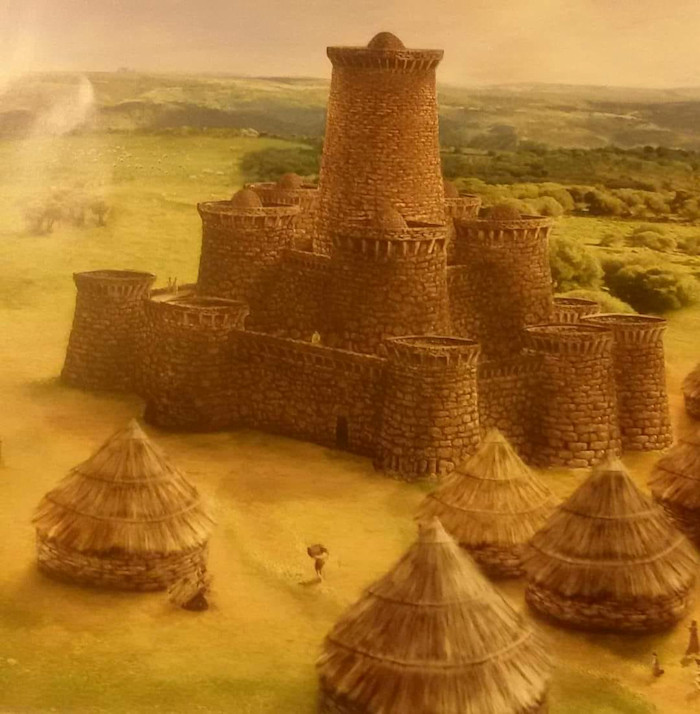
Nuraghic Tholos Watchtower Fortress
Sardinia, ~1300 BC
Sardinia, ~1300 BC
While Helen may very well have had the beauty that launched a thousand ships to Troy VI, but the economic imperatives the Mycenaean royalty faced with the dwindling returns from their obsessive plundering in the western Mediterranean made the riches of Troy an enticement that would finance the draining of Lake Kopais, the building of the Tiryns Dam, the construction of additional roadways, royal chamber tombs, and large tholos tombs.
With Troy VI attacked and thoroughly looted and destroyed the Mycenaean elites turned their attention to the projects that concerned them with the wealth of Troy just as they did with the “rich in gold” wealth of Minoan Crete a few hundred years before. Meanwhile, the Sardinians (Shardana or Sherden) and their allies came into the Eastern Mediterranean to gather intelligence especially on what they considered the evil, psychopathic elites of the Mycenaeans as well as the other powers such as the Hittites, Egyptians, and in Byblos in the Levant. Also, they began to setup secret naval bases on the Lycian peninsula in southwest Asia Minor probably at the urging of their allies in Byblos. The Lycian peninsula was quite strategic, at this time, located about midway between the Mycenaeans in the Aegean, the Egyptian Nile delta, and the inland and coastal Hittites. The Sardinians that settled there would come to be known as the Lukka. They could preposition ships and weapons in Lycia in order to launch attacks from there instead of Sardinia which is several days more distant if they wished.
With Troy VI attacked and thoroughly looted and destroyed the Mycenaean elites turned their attention to the projects that concerned them with the wealth of Troy just as they did with the “rich in gold” wealth of Minoan Crete a few hundred years before. Meanwhile, the Sardinians (Shardana or Sherden) and their allies came into the Eastern Mediterranean to gather intelligence especially on what they considered the evil, psychopathic elites of the Mycenaeans as well as the other powers such as the Hittites, Egyptians, and in Byblos in the Levant. Also, they began to setup secret naval bases on the Lycian peninsula in southwest Asia Minor probably at the urging of their allies in Byblos. The Lycian peninsula was quite strategic, at this time, located about midway between the Mycenaeans in the Aegean, the Egyptian Nile delta, and the inland and coastal Hittites. The Sardinians that settled there would come to be known as the Lukka. They could preposition ships and weapons in Lycia in order to launch attacks from there instead of Sardinia which is several days more distant if they wished.
The Destruction of the Drainage Project of Lake Kopais, Boeotia and Mycenaean Trap
Their spies paid particular attention to the massive drainage project of Lake Kopais and its weaknesses with the intent to see it completed and begin harvesting crops of wheat to feed the Mycenaeans so they could begin destructively raiding the harvested wheat crop and attack their defenses at Orcomemos and the fortress at Glas. The probable preferred landing site for raids on the wheat fields of Kopais was the coasts adjacent to the Bronze Age settlement of Mitrou, a North Euboean Gulf tidal islet in the Bay of Atalanti in East Lokris, Greece. As the crow flies, it was 12.85 miles (20.68 kms) from Orcomenos to the SW and 10.79 miles (17.36 kms) from the fortress of Glas to the SSE. This makes for the shortest marches on disembarking from their ships.
Throughout the beginning and middle of the 13th Century BC sporadic raiding by the Mycenaeans and the Sardinians and their allies remained the order of the day, but towards the end of the century the Sardinian alliance began to plan for the total destruction of the Mycenaean fleet as a precursor for a massive invasion of the Peloponnese and the Gulf of Argolis. The Sardinians and their allies intensely hated the Mycenaeans and wished nothing more than to take comprehensive revenge on them for the carnage and abuse of their homelands since the 15th century BC.
Perhaps it was the final destruction of the massive drainage works and flooding of the wheat crops just before harvest time in the Kopais basin that lured the Mycenaeans to invade Sardinia one last time or the rumor of the location of Tin mines had been found into the Sardinian trap. But, “some” catastrophe befell the Mycenaean fleet. The Pylos Linear B tablets that describe “Watchers by the Sea” weren’t meant to spot Mycenaean ships but enemy ships targeting Messenia for an amphibious invasion. Perhaps the royalty in Mycenae had enough of the final destruction of the drainage works of the Kopais basin and the fortress of Glas or actually came to believe the disinformation there was Cassiterite, or even better processed Tin, available for the taking in the nearby mountains (actually on mainland Italy in Tuscany!) that are on either side of Cagliari Gulf. With little in the way of wheat to feed their warriors or Tin for their Bronze weapons their “God like” elites, self assured of their success, began to plan another massive last ditch raid on Sardinia in the southern Gulf of Cagliari. The Mycenaean trap was set.
Throughout the beginning and middle of the 13th Century BC sporadic raiding by the Mycenaeans and the Sardinians and their allies remained the order of the day, but towards the end of the century the Sardinian alliance began to plan for the total destruction of the Mycenaean fleet as a precursor for a massive invasion of the Peloponnese and the Gulf of Argolis. The Sardinians and their allies intensely hated the Mycenaeans and wished nothing more than to take comprehensive revenge on them for the carnage and abuse of their homelands since the 15th century BC.
Perhaps it was the final destruction of the massive drainage works and flooding of the wheat crops just before harvest time in the Kopais basin that lured the Mycenaeans to invade Sardinia one last time or the rumor of the location of Tin mines had been found into the Sardinian trap. But, “some” catastrophe befell the Mycenaean fleet. The Pylos Linear B tablets that describe “Watchers by the Sea” weren’t meant to spot Mycenaean ships but enemy ships targeting Messenia for an amphibious invasion. Perhaps the royalty in Mycenae had enough of the final destruction of the drainage works of the Kopais basin and the fortress of Glas or actually came to believe the disinformation there was Cassiterite, or even better processed Tin, available for the taking in the nearby mountains (actually on mainland Italy in Tuscany!) that are on either side of Cagliari Gulf. With little in the way of wheat to feed their warriors or Tin for their Bronze weapons their “God like” elites, self assured of their success, began to plan another massive last ditch raid on Sardinia in the southern Gulf of Cagliari. The Mycenaean trap was set.
The Final Mycenaean Raid on Sardinia
When the many hundreds of Mycenaean ships began their daylight landing on the beaches of Cagliari everything appeared as before. The high tholos watchtowers set their fires and blew their horns to alert the local population of the raid. Everyone inland began to run, leading their farm animals, to their nearest tholos fortress shelters and, unseen by the Mycenaeans because of their narrow beams, the watchtower’s Bronze mirrors began to report the Mycenaean warrior’s movements. The Sardinians knew the trap had worked when the watchtowers began to report the movement of a large group of warriors moving into the mountainous valley of the fictitious Cassiterite (Tin) mines.
The Sardinians were equipped with the relatively new “Naue II” Bronze sword with its weighted blade so it could be used as a sharp club for downward strikes onto the Mycenaean’s Boars Tusk Helmets (Homer, Iliad, Book 10). Once this group of warriors was well beyond the entrance of the valley a force of Sardinians moved to block their exit once they found they had been fooled. Prepositioned archers high on the slopes of the valley began to rain down arrows of their superior Bronze onto the Mycenaean warriors as the Sardinian soldiers blocking their exit began to march up the valley to destroy them.
The Sardinians were equipped with the relatively new “Naue II” Bronze sword with its weighted blade so it could be used as a sharp club for downward strikes onto the Mycenaean’s Boars Tusk Helmets (Homer, Iliad, Book 10). Once this group of warriors was well beyond the entrance of the valley a force of Sardinians moved to block their exit once they found they had been fooled. Prepositioned archers high on the slopes of the valley began to rain down arrows of their superior Bronze onto the Mycenaean warriors as the Sardinian soldiers blocking their exit began to march up the valley to destroy them.

Bronze Naue II Sword
Sardinia, ~1200 BC
Sardinia, ~1200 BC
This was far from the only campaign the Sardinians planned for. It intended to have it’s fleet try to block the Mycenaean fleet from escaping by having their many hidden ships to move in from both sides of the Gulf. Then, realizing the Mycenaeans that stayed on their ships would hesitate before abandoning their disembarked fighters from putting out to the open sea, to have the massive forces hidden in the mountains on both sides of the Cagliari landing beaches rush in to block the Mycenaean warriors from returning to their ships. This plan was meant to destroy the totality of the Mycenaean warriors on land and to capture as much of their fleet as they could at sea. Twenty-four (24) hours later only a remnant of weary Mycenaean warriors were still fighting as Sardinian forces from the North descended upon them. The Sardinian army was built for mobility with their light round shields and “Naue II” Bronze swords unlike the Mycenaeans who preferred a stabbing, slicing sword and a static defensive posture. Many Boars Tusk helmets were burst by these swords and many skulls were cracked. Most of the invading fleet was captured with only a few ships escaping to make their way back to Pylos who sent “Watchers by the Sea” on the coast and then on to Naplion and Mycenae to tell of this comprehensive disaster.

Mycenaean Warrior Military Garb
Mycenae, Greece
about 1200 BC
Mycenae, Greece
about 1200 BC
With tens of thousands of Mycenaean soldiers laying dead in the bloodied fields the Sardinians held them in such contempt that any wounded casualties they came across were swiftly shown no mercy. The Sardinians took account of their killed and wounded losses and found that their casualties was a minor fraction of their overall military strength due to their superior Bronze weapons and tactics. It was decided that there was never a time to attack their hated Mycenaean enemy than now. So they gave some days for the lightly wounded to heal and regrouped their forces before setting off on their great fleet of ships that now included hundreds of Mycenaean ships.
The Sardinian Invasion and Mycenaean Expulsion
When they eventually set off to Pylos in Messenia and the beaches of the northern Gulf of Argolis just south of Mycenae they knew that their enemy was basically defenseless. They intended to cast the evil out of their homelands by “enforced expulsion” – the most extreme form of ethnic cleansing in the land of the pathological Mycenaeans. The “God-like” empathy-less psychopathy of the Mycenaean royal elites was blamed on an entire people and now everyone was to be burned out and thrown off their homeland. But, this has been true throughout history. If a tyrannical political leader is able use the state to point a sword or a gun to the head of every individual citizen then they will fight for the tyrant. A good example of this is Nazi Germany under the psychopath Hitler. Was Agamemnon a narcissistic psychopath? Probably!
The forced expulsion of the Mycenaeans from their homeland was the cause that started the dominoes to fall and all of the resulting chaos. Everything from the fall of Troy VII, the Nine Bows Confederacy that attacked Egypt's western Nile delta at the Battle of Perire, the fall of the Hittites, the near collapse of the Egyptians from the land “Battle of Djahy” in Canaan, the sea “Battle of the Nile Delta”, and the Egyptian allocation of land for the many wandering Mycenaeans (later known as the Philistines), who had tried so hard to take the fertile Nile Delta with Sardinian help, just to the northeast of the Nile Delta in southern Canaan as a buffer to northern invasion. But, this vacuum of chaos gave way to the “Rise of Phoenicians”.
The forced expulsion of the Mycenaeans from their homeland was the cause that started the dominoes to fall and all of the resulting chaos. Everything from the fall of Troy VII, the Nine Bows Confederacy that attacked Egypt's western Nile delta at the Battle of Perire, the fall of the Hittites, the near collapse of the Egyptians from the land “Battle of Djahy” in Canaan, the sea “Battle of the Nile Delta”, and the Egyptian allocation of land for the many wandering Mycenaeans (later known as the Philistines), who had tried so hard to take the fertile Nile Delta with Sardinian help, just to the northeast of the Nile Delta in southern Canaan as a buffer to northern invasion. But, this vacuum of chaos gave way to the “Rise of Phoenicians”.
Note:
It’s well known that archaeologists are wonderful discoverers of evidence of the past but many are not well founded in the methodologies of science. Also, there is an almost non-existent presence among archaeologists, especially the elites, of experienced mariners knowledgeable in star navigation which would allow them to understand how the ancient mariners accurately navigated from point to point in, especially, the highly enclosed Mediterranean Sea. Therefore, their ability to interpret the overall technological ancient context of what they discover is quite limited.
Facebook Conversation I had with Eric Cline - April 9th, 2024:
W. Sheppard Baird
Would you accept, the Shardana of the Nuragic civilization on the island of Sardinia could be the culprit behind the end of the Bronze Age. And, why not, with a no!
Eric Cline
Certainly perhaps partially, as one of the groups of the Sea Peoples, as you already know that I say in 1177 BC. But you also know that in my opinion the Sea Peoples were only part of the perfect storm of calamities...
W. Sheppard Baird
The "bland" cause you mention, the "perfect storm of calamities". Why not a war between Nuragic Sardinians and Mycenaeans. The Nuragic Stone Towers were the perfect defense, given the weapons of the day! Do you deny they existed !??!
Eric Cline
Of course the stone towers exist; but extrapolating from that to postulating a full-blown war between Mycenaeans and Sardinians is a real stretch, quickly frankly, without any other supporting archaeological or textual evidence. Leaving aside the towers, what other indication is there anywhere of an actual war fought between the Nuragic Sardinians and the Mycenaeans? And, if you really want the towers to be "the perfect defense," why do you have to go all the way to the Mycenaean Greek mainland to find an enemy who might attack the Sardinians? Surely the inhabitants of Iberia, or northern Italy, or somewhere else much closer would be as likely, if not more likely? I just don't see any "there" there...
W. Sheppard Baird
Is a real stretch ??? The archaeological evidence if you overlook it in favor "perfect storm of calamities" and don't forget written textual evidence doesn't exist !!! How did the Shardana get into the eastern Mediterranean Sea, if not by ships? Have you ever sailed on the Mediterranean Sea?? It takes about 10 days rowing/sailing between Greece and the island of Sardinia. If ten days isn't enough time to mount a naval amphibious attack when the Mycenaeans want something of yours. How do you explain the evidence of the Heinrich Schliemann discovery of the "Warrior Vase" from Circle A in Mycenae and the "Bronze Nuraghic Warriors" - https://www.minoanatlantis.com/End_Bronze_Age.php . I just don't see any "there" there...
Would you accept, the Shardana of the Nuragic civilization on the island of Sardinia could be the culprit behind the end of the Bronze Age. And, why not, with a no!
Eric Cline
Certainly perhaps partially, as one of the groups of the Sea Peoples, as you already know that I say in 1177 BC. But you also know that in my opinion the Sea Peoples were only part of the perfect storm of calamities...
W. Sheppard Baird
The "bland" cause you mention, the "perfect storm of calamities". Why not a war between Nuragic Sardinians and Mycenaeans. The Nuragic Stone Towers were the perfect defense, given the weapons of the day! Do you deny they existed !??!
Eric Cline
Of course the stone towers exist; but extrapolating from that to postulating a full-blown war between Mycenaeans and Sardinians is a real stretch, quickly frankly, without any other supporting archaeological or textual evidence. Leaving aside the towers, what other indication is there anywhere of an actual war fought between the Nuragic Sardinians and the Mycenaeans? And, if you really want the towers to be "the perfect defense," why do you have to go all the way to the Mycenaean Greek mainland to find an enemy who might attack the Sardinians? Surely the inhabitants of Iberia, or northern Italy, or somewhere else much closer would be as likely, if not more likely? I just don't see any "there" there...
W. Sheppard Baird
Is a real stretch ??? The archaeological evidence if you overlook it in favor "perfect storm of calamities" and don't forget written textual evidence doesn't exist !!! How did the Shardana get into the eastern Mediterranean Sea, if not by ships? Have you ever sailed on the Mediterranean Sea?? It takes about 10 days rowing/sailing between Greece and the island of Sardinia. If ten days isn't enough time to mount a naval amphibious attack when the Mycenaeans want something of yours. How do you explain the evidence of the Heinrich Schliemann discovery of the "Warrior Vase" from Circle A in Mycenae and the "Bronze Nuraghic Warriors" - https://www.minoanatlantis.com/End_Bronze_Age.php . I just don't see any "there" there...
Bibliography:
Aleydis Van de Moortel, Vitale S., 2018, Changing Political Landscapes: Mitrou, East Lokris, and the Palatial Polities of Boeotia
Boaretto E. et al., 2018, The Chronology of the Late Bronze (LB)-Iron Age (IA) Transition in the Southern Levant: A Response to Finklestein's Critique
Cáceres L. et al., 2018, Modelling the mid-late Holocene evolution of the Huelva Estuary and its human colonization, South-Western Spain
Friedrich, et al, 2006, Santorini Eruption Radiocarbon Dated to 1627 - 1600 BC
Georganas I., 2012, Weapons and Warfare, The Oxford Handbook of the Bronze Age Aegean
Giannakos K., 2013, Aegean Type Swords and Finds in Anatolia, Technology of Metals and Structures, Written Sources and the Dating of Trojan War
Gradolia M., et al., 2020, Cyprus and Sardinia in the Late Bronze Age: Nuragic table ware at Hala Sultan Tekke
Horn C., Kristiansen K., 2018, Introducing Bronze Age Warfare
Jung R., 2018, Push and Pull Factors of the Sea Peoples between Italy and the Levant
Jung R. & Mehofer M., 2006, A Sword of Naue II Type from Ugarit and the Historical Significance of Italian-type Weaponry in the Eastern Mediterranean
Kelder J., 2020, A Thousand Black Ships: Maritime Trade, Diplomatic Relations, and the Rise of Mycenae
Kelder J., Waal W., 2019, ‘My brother, a Great King, my peer’. Evidence for a Mycenaean kingdom from Hittite texts
Knapp A. B., Manning S., 2016, Crisis in Context: The End of the Late Bronze Age in the Eastern Mediterranean
Kristiansen K., Suchowska-Ducke P., 2015, Connected Histories: the Dynamics of Bronze Age Interaction and Trade 1500–1100 BC
Lane M. F. et al., 2020, The Aroura Project, Discoveries in Central Greece, 2010–2014
Lane M. F. et al., 2016, Archaeological geophysics of a Bronze Age agricultural landscape: the Aroura Project, central mainland Greece
Ling J., 2019, Moving metals IV: Swords, metal sources and trade networks in Bronze Age Europe
Lull V. et al., 2011, El Argar and the Beginning of Class Society in the western Mediterraean
Marazzi M., 2018, The ‘Administered’ System of Trans-Mediterraean Maritime Relations at the End of the 2nd Millennium BC: Apogee and Collapse
Marazzi M., 2018, Corsairs, Pirates, Traders, or Nomads of the Sea? Socioeconomic Changes in the Mediterranean at the End of the 13th Cent. B.C.E.
Mederos, A., 2017, The Mycenaean contacts with the Iberian Peninsula during the Late Bronze Age (1625-1150 BC)
Middleton G., 2015, Telling Stories: The Mycenaean Origins of the Philistines
Molloy B., 2016, Nought may Endure but Mutability: Eclectic Encounters and Material Change in the 13th to 11th Centuries BC Aegean
Molloy B., 2013, Malice in Wonderland: The Role of Warfare in ‘Minoan’ Society
Molloy B., 2010, Swords and Swordsmanship in the Aegean Bronze Age
Nomikou L., 2016, Post-eruptive flooding of Santorini caldera and implications for tsunami generation
Novikova T. et al., 2011, Modelling of tsunami generated by the giant Late Bronze Age eruption of Thera, South Aegean Sea, Greece
Pampaloni, A., Zullo V., 2018, Sull’antica Lupatia con qualche divagazione... (in Italian)
Pampaloni, A., 2017, The tin of Campigliese: 40 centuries of usage
Pampaloni, A., 2017, Lead Isotopes analysis risks and errors
Pavuk P., 2011, Between the Aegeans and the Hittites Western Anatolia in the 2nd Millennium BC
Perra, M., 2014, Il Civico Museo Archeologico “Genna Maria” di Villanovaforru Mauro
Stocker S., Davis J., 2017, The Combat Agate from the Grave of the Griffin Warrior at Pylos
Suchowska-Ducke P., 2016, The Mycenaeans and Europe: Long-distance networks and cross-cultural communication
Wardle, et al, 2014, Assiros Toumba End of Greek Bronze Age
Wiener M., 2015, The Mycenaean Conquest Of Minoan Crete
Boaretto E. et al., 2018, The Chronology of the Late Bronze (LB)-Iron Age (IA) Transition in the Southern Levant: A Response to Finklestein's Critique
Cáceres L. et al., 2018, Modelling the mid-late Holocene evolution of the Huelva Estuary and its human colonization, South-Western Spain
Friedrich, et al, 2006, Santorini Eruption Radiocarbon Dated to 1627 - 1600 BC
Georganas I., 2012, Weapons and Warfare, The Oxford Handbook of the Bronze Age Aegean
Giannakos K., 2013, Aegean Type Swords and Finds in Anatolia, Technology of Metals and Structures, Written Sources and the Dating of Trojan War
Gradolia M., et al., 2020, Cyprus and Sardinia in the Late Bronze Age: Nuragic table ware at Hala Sultan Tekke
Horn C., Kristiansen K., 2018, Introducing Bronze Age Warfare
Jung R., 2018, Push and Pull Factors of the Sea Peoples between Italy and the Levant
Jung R. & Mehofer M., 2006, A Sword of Naue II Type from Ugarit and the Historical Significance of Italian-type Weaponry in the Eastern Mediterranean
Kelder J., 2020, A Thousand Black Ships: Maritime Trade, Diplomatic Relations, and the Rise of Mycenae
Kelder J., Waal W., 2019, ‘My brother, a Great King, my peer’. Evidence for a Mycenaean kingdom from Hittite texts
Knapp A. B., Manning S., 2016, Crisis in Context: The End of the Late Bronze Age in the Eastern Mediterranean
Kristiansen K., Suchowska-Ducke P., 2015, Connected Histories: the Dynamics of Bronze Age Interaction and Trade 1500–1100 BC
Lane M. F. et al., 2020, The Aroura Project, Discoveries in Central Greece, 2010–2014
Lane M. F. et al., 2016, Archaeological geophysics of a Bronze Age agricultural landscape: the Aroura Project, central mainland Greece
Ling J., 2019, Moving metals IV: Swords, metal sources and trade networks in Bronze Age Europe
Lull V. et al., 2011, El Argar and the Beginning of Class Society in the western Mediterraean
Marazzi M., 2018, The ‘Administered’ System of Trans-Mediterraean Maritime Relations at the End of the 2nd Millennium BC: Apogee and Collapse
Marazzi M., 2018, Corsairs, Pirates, Traders, or Nomads of the Sea? Socioeconomic Changes in the Mediterranean at the End of the 13th Cent. B.C.E.
Mederos, A., 2017, The Mycenaean contacts with the Iberian Peninsula during the Late Bronze Age (1625-1150 BC)
Middleton G., 2015, Telling Stories: The Mycenaean Origins of the Philistines
Molloy B., 2016, Nought may Endure but Mutability: Eclectic Encounters and Material Change in the 13th to 11th Centuries BC Aegean
Molloy B., 2013, Malice in Wonderland: The Role of Warfare in ‘Minoan’ Society
Molloy B., 2010, Swords and Swordsmanship in the Aegean Bronze Age
Nomikou L., 2016, Post-eruptive flooding of Santorini caldera and implications for tsunami generation
Novikova T. et al., 2011, Modelling of tsunami generated by the giant Late Bronze Age eruption of Thera, South Aegean Sea, Greece
Pampaloni, A., Zullo V., 2018, Sull’antica Lupatia con qualche divagazione... (in Italian)
Pampaloni, A., 2017, The tin of Campigliese: 40 centuries of usage
Pampaloni, A., 2017, Lead Isotopes analysis risks and errors
Pavuk P., 2011, Between the Aegeans and the Hittites Western Anatolia in the 2nd Millennium BC
Perra, M., 2014, Il Civico Museo Archeologico “Genna Maria” di Villanovaforru Mauro
Stocker S., Davis J., 2017, The Combat Agate from the Grave of the Griffin Warrior at Pylos
Suchowska-Ducke P., 2016, The Mycenaeans and Europe: Long-distance networks and cross-cultural communication
Wardle, et al, 2014, Assiros Toumba End of Greek Bronze Age
Wiener M., 2015, The Mycenaean Conquest Of Minoan Crete
February 2, 2022
W. Sheppard Baird
Copyright © 2007, 2024 W. Sheppard Baird
All Rights Reserved
All Rights Reserved
-

Map of Akrotiri Archaeological Site
Santorini (Thera), Greece
-

Plan of Knossos Palace
Crete, Greece
-

Spring Fresco West Wall
Swallows Scene
Akrotiri, Santorini, Greece
-

Minoan Dolphins Fresco
Knossos, Crete, Greece
-
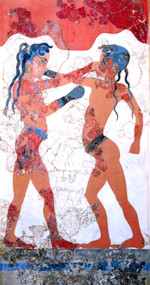
Minoan Boxing Boys Fresco
Akrotiri, Santorini, Greece
-

Lady Escaping the Minoan Eruption
Melos to Chania
Aegean Sea, Greece
-

Minoan Ladies in Blue Fresco
Knossos, Crete, Greece
-
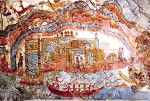
Minoan Miniature Frieze
Admirals Flotilla Fresco
Thera Scene
West House, Room 5, South Wall
Akrotiri, Santorini, Greece
-

Minoan Miniature Frieze
Admirals Flotilla Fresco
Shipping Scene Restoration
West House, Room 5, South Wall
Akrotiri, Santorini, Greece
-
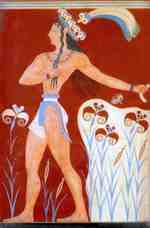
Minoan Priest King
Feathered Prince of Lilies Fresco
Knossos, Crete, Greece
-
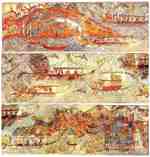
Minoan Miniature Frieze
Admirals Flotilla Fresco
in Three Panels
West House, Room 5, South Wall
Akrotiri, Santorini, Greece
-

Minoan Antelope Fresco
Akrotiri, Santorini, Greece
-

Minoan Dolphins Restoration Fresco
Knossos, Crete, Greece
-
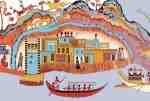
Minoan Miniature Frieze
Admirals Flotilla Fresco
Thera Restoration Scene
West House, Room 5, South Wall
Akrotiri, Santorini, Greece
-

Minoan Boxing Boys Restoration Fresco
Akrotiri, Santorini, Greece
-

Minoan Sea Daffodils Lilies Fresco
Akrotiri, Santorini, Greece
-
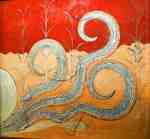
Minoan Octopus Fresco
Knossos, Crete, Greece
-

Minoan Bull Leaping Toreador Fresco
Knossos, Crete, Greece
-

Minoan Bull Leaping Toreador Restoration Fresco
Knossos, Crete, Greece
-

Minoan Sea Daffodils Lilies Restoration Fresco
Akrotiri, Santorini, Greece
-

Minoan Antelope Restoration Fresco
Akrotiri, Santorini, Greece